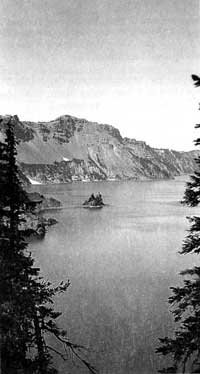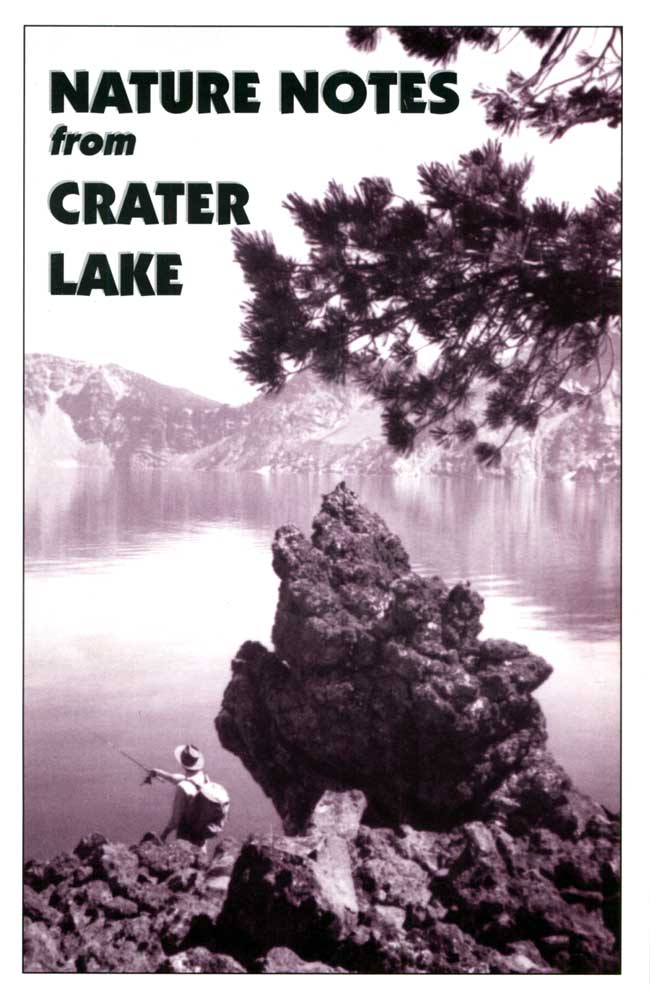Volume 27, 1996
All material courtesy of the National Park Service.These publications can also be found at http://npshistory.com/
Nature Notes is produced by the National Park Service. © 1996
Introduction
Work on a new fuel line and the Cleetwood Cove Trail prevented last year’s visitors from fishing or taking boat tours, so the summer of 1999 promises a return to Crater Lake. Not since 1952 had a whole season passed without public access to the water, so it seemed fitting to begin this edition of Nature Notes with articles about the lake and the spectacular geological story it represents.
As anyone who has experienced the beauty found in its forests, wet lands, and even barren areas will readily attest, there is more to Crater Lake National Park than its central feature. Since each part of the park contains something of interest, Nature Notes is devoted to providing visitors with information they might not otherwise obtain on their own. In this edition, for example, there are articles on how to identify the various sedges, a rare wildflower called Mount Mazama collomia, and why weather plays a some times defining role in the visitor experience.
Change occurring over the length of one, possibly two, lifetimes is the common thread among the last three contributions. One article touches on the importance of memory to continuity in the park, while another piece about the habits and management of bears is essentially a retrospective. The last article describes what can be found in the seemingly mundane area around Whitehorse Creek in order to emphasize that repeated visits often result in new understanding about a place.
Nature Notes from Crater Lake is made possible by the Crater Lake Natural History Association, now in its 58th year. It sponsors this publication as part of an ongoing commitment to support the educational and resource management programs of the National Park Service. Please join them in this effort by becoming a member of CLNHA and receive a 15 percent discount on items sold in the William G. Steel Center at Park Headquarters or at the summer visitor center located in Rim Village.
 Phantom Ship from Kerr Notch in 1936.
Phantom Ship from Kerr Notch in 1936.
Homer Marion photo, NPS files.
Mount Mazama (Crater Lake)
These breathless tones are but a bier,
Within these cliffs are tears of blue,
The brilliance of each morning unfolds
A massive shroud of ethereal hue
Where once a feverish, fiery tongue
Lapped for the coolness of the stars
In agony, as flowing blood had wrought
A futile effort to heal the festered scars.
Now pinned to its breast a ghostly ship
Sailing forever on a windless sea,
No port shall ever lure to rest
Till God sees fit to set it free.
We come to drink of this beauty
Which was born in the throes of death
Centuries have found it unchanging,
The living has given its breath.
Ruth Neary, 1959
Adventure & Discovery, 1931: A Personal Account
During the summer of 1931, at 19 years of age, I was privileged to accompany Ansel F. Hall, senior naturalist and chief forester of the National Park Service (NPS), as his “apprentice” field assistant. He was an active Scouter, known affectionately as “Chief” by me and all the other Boy Scouts whom he befriended.1 Our itinerary included Yosemite, Craters of the Moon, Yellowstone, Grand Teton, and Crater Lake. I had just completed my freshman year at the University of California and was contemplating what major to select. To help me decide, Chief said he would give me as many different assignments as possible while he was on duty at these parks. In return I agreed to write a book describing my experiences so that others could consider a NPS career. This paper is derived from the chapters I wrote about Crater Lake. Part one deals with interpretive activities inaugurated that summer; part two relates to geological and historical discoveries.
Part One – Interpretation
Park Naturalist Donald S. Libbey had been planning a new service for the public for quite some time.2 I was happy when he and chief asked me to go along to assist with the first, personally-conducted, rim auto- caravan trip. Following the regular evening programs at the Community House3 and at the Lodge, it was announced that those desiring to participate in this new service would meet at eight o’clock the next morning at the Sinnott Memorial for orientation. They would then travel in their own cars with the naturalist’s car in the lead, and stops would be made at important view points. The naturalist would point out the significant features at each of these, once those attending left their cars and assembled at a central location.
We wondered how many people would come. Great was our surprise to find 12 autos lined up and 27 people ready to go.
To the group assembled on the Sinnott Memorial’s parapet, Mr. Libbey described the lake’s geological history and the evidence to support it. He concluded by giving instructions about how the balance of the trip would be conducted.
Returning to the autos, we traveled around the rim in a clockwise direction following the government “pilot” car. By the time we reached The Watchman, only five miles from the start, our caravan had grown to 18 vehicles carrying 47 people. It was my duty to record the mileage to each of the 11 stops, to list the principal subjects mentioned by Mr. Libbey, and to note the length of time spent at each one. The stops averaged about 15 minutes, which allowed plenty of time for the visitors to enjoy the view and to ask questions.



